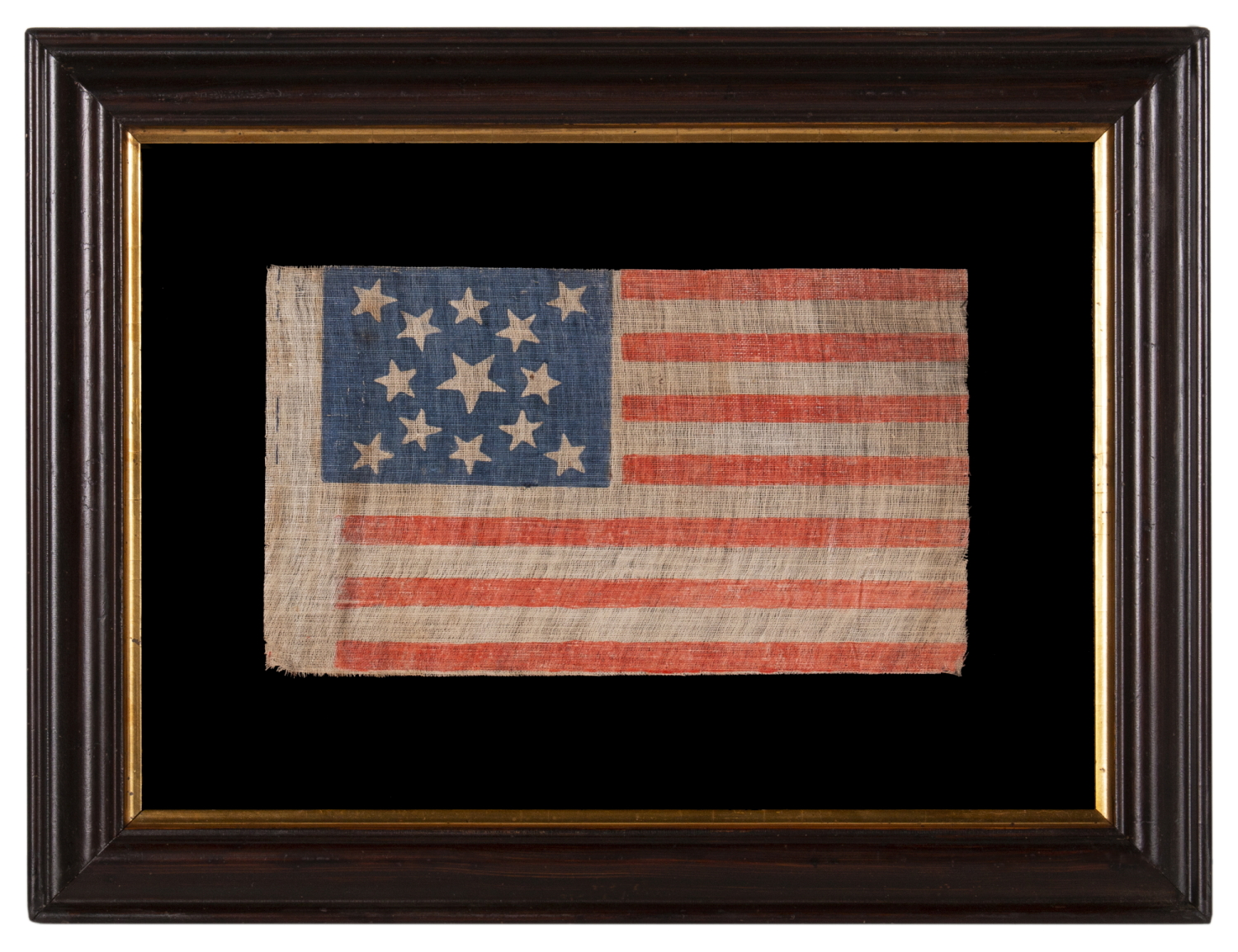
| |
13 STARS IN A MEDALLION PATTERN ON AN ANTIQUE AMERICAN PARADE FLAG MADE SOMETIME BETWEEN THE CIVIL WAR (1861-1865) AND THE 1876 CENTENNIAL OF AMERICAN INDEPENDENCE, WITH A BEAUTIFUL, CORNFLOWER BLUE CANTON AND IN AN UNUSUALLY LARGE SIZE AMONG ITS COUNTERPARTS |
|
| Available: |
Sold |
| Frame Size (H x L): |
12.5" x 16.5" |
| Flag Size (H x L): |
5.75" x 9.75" |
|
| Description....: |
|
13 star American national parade flag, block-printed on coarse cotton. The stars are arranged in a medallion that consists of a large center star, surrounded by a wreath of eight stars, with a flanking star in each corner of the blue canton. Although this design was especially popular at the time of the 100-year anniversary of our nation’s independence in 1876, it begins to emerge on a much smaller number of both parade flags and sewn flags made during the American Civil War (1861-65). This particular example may have been made at any time within that 15-year time frame. Note the crude weave of the gauze-like fabric, the grain of which has a sweeping curve that adds great texture to its presentation.
While the size of the flag may seem small, it is actually larger than most of its counterparts with 13 stars that were made during this era. Note the irregularity in the size arms of the large star in particular, which adds an interesting element to the flag's visual presentation.
Many parade flags printed between 1850 and 1890 have shades of red that lean strongly toward orange. These were printed with a pigment colored with madder, which has a red-orange hue. Note how beautifully this contrasts with the cornflower blue canton.
13 star flags have been flown throughout our nation’s history for a variety of purposes. In addition to their use at the centennial, 13 star flag were hoisted at other patriotic events, including Lafayette’s visit in 1824-25, the celebration of the nation’s centennial in 1876, and the sesquicentennial in 1926. They were displayed during the Civil War, to reference past struggles for American liberty and victory over oppression, and were used by 19th century politicians in political campaigning for the same reason. The U.S. Navy used the 13 star count on small boats until 1916, because it was easier to discern fewer stars at a distance on a small flag. Commercial flag-makers mirrored this practice, and some private ships flew 13 star flags during the same period as the Navy. The use of yachting ensigns with a wreath of 13 stars surrounding a fouled anchor, which allowed pleasure boats to bypass customs between 1848 and 1980, persists today without an official purpose.
Mounting: The flag was mounted and framed in our own textile conservation department, which is led by expert staff. We take great care in the mounting and preservation of flags and have framed thousands of examples.
The paint-decorated and gilded molding dates to the period between 1840 and 1870. The flag has been hand-stitched to a background of 100% cotton twill, black in color, that has been washed and treated for colorfastness. Spacers keep the textile away from the glazing, which is U.V. protective glass.
Condition: There is modest fading, minor soiling, and very minor fraying at the fly end and at the top and bottom of the hoist. There is a tiny amount of misprinting of blue pigment along the white area of the hoist. Many of my clients prefer early flags to show their age and history of use. |
|
|
|
| Collector Level: |
Beginners and Holiday Gift Giving |
|
| Flag Type: |
Parade flag |
|
| Star Count: |
13 |
|
| Earliest Date of Origin: |
1861 |
|
| Latest Date of Origin: |
1876 |
|
| State/Affiliation: |
13 Original Colonies |
|
| War Association: |
|
|
| Price: |
SOLD |
|
| |
Views: 399 |
|
|
|

